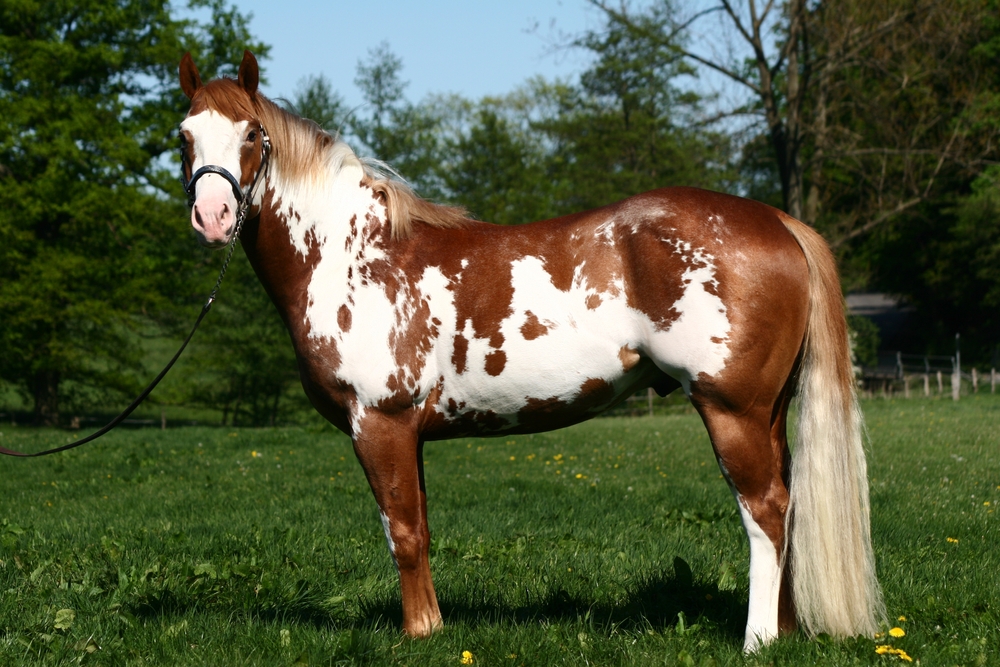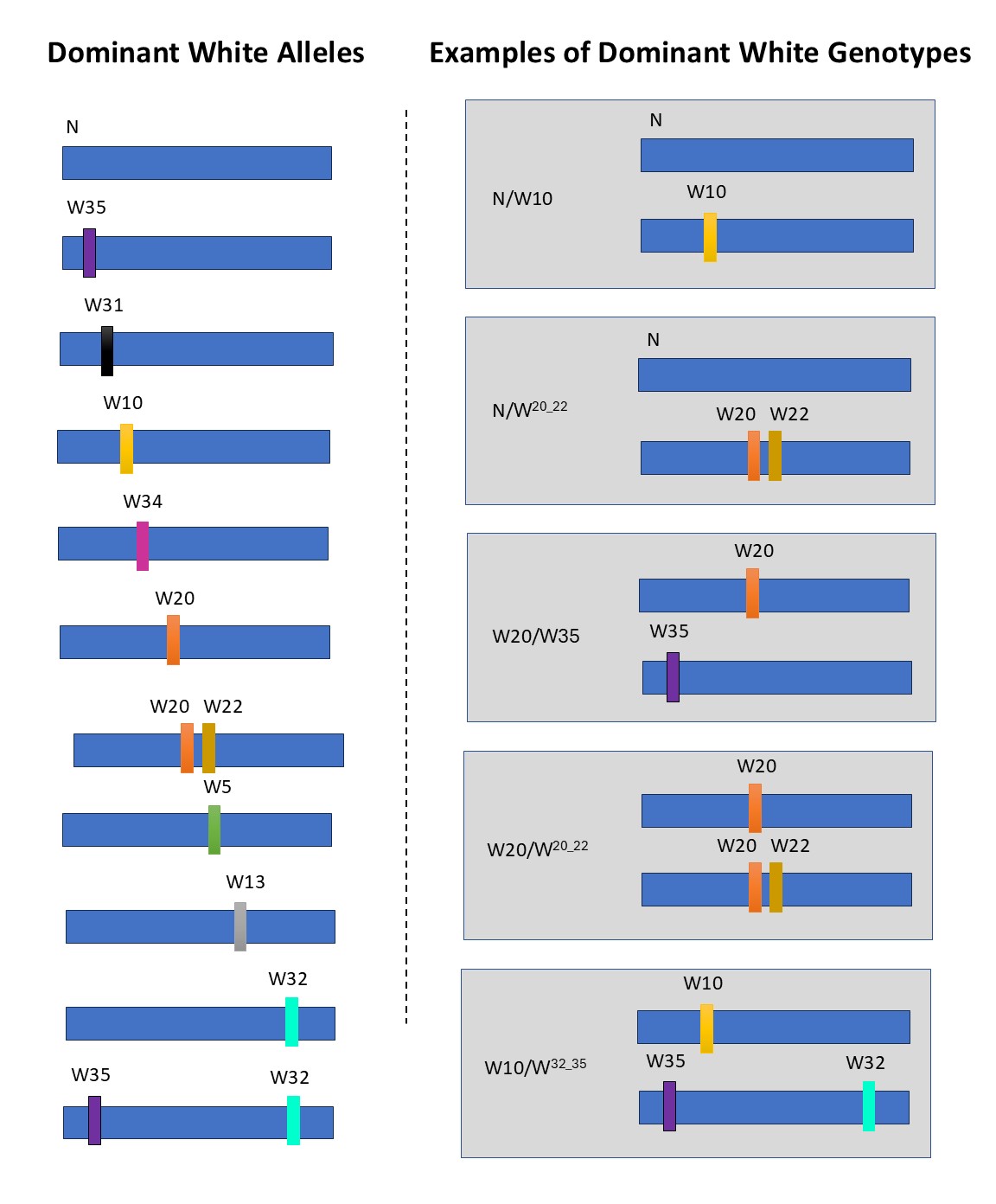Quick Summary

The American Paint Horse Association (APHA) currently recognizes the following white-spotting patterns and alleles for Regular Registry consideration:
- Frame Overo (also known as Lethal White Overo)
- Tobiano
- Sabino 1
- Splashed White 1, 2, 3, 5, 6, 7, 8
- Dominant White 5, 10, 20, 22, 31, 32, 34, 35
For more on APHA registration requirements, please visit the APHA website.
Lethal White Overo/Frame Overo
Lethal white overo (LWO) has also been called frame overo and abbreviated to LWO. It is also known as overo lethal white syndrome or OLWS for short. This genetic disorder results from having two copies of the allele that causes the frame overo white coat pattern. Horses with one copy have a frame pattern that can vary in the amount of white spotting, while those with two copies have the lethal white overo syndrome, which is incompatible with life. Read more about Lethal White Overo.
Tobiano
Tobiano is a white spotting pattern characterized by white on the body that crosses the topline. The extent of white patterning caused by tobiano can vary among horses with the tobiano allele. Read more about Tobiano.
Sabino 1
Sabino is a white spotting pattern that is characterized by white markings on legs, often accompanied by white ticking or roaning of the midsection and a blaze on the face. The amount of white patterning can vary, similar to all types of white patterning. Read more about Sabino 1.
Splashed White (SW1, SW2, SW3, SW5, SW6, SW7, SW8, & SW4)
Splashed white is a variable white spotting pattern characterized by a broad blaze, extended white markings on the legs, variable white spotting on the belly, and often one or both blue eyes. This pattern gets its name because these horses often look as if they have splashed around in white paint. Eight mutations in two different genes have been shown to cause the splashed white pattern. APHA recognizes SW1, SW2, SW3, SW5, SW6, SW7 and SW8. SW4 is currently not an allele for consideration for APHA registration, but SW4 is included in the VGL test for allelic series completeness. Read more about Splashed White.
Dominant White (W5, W10, W20, W22, W31, W32, W34, W35, & W13)
Dominant white is a variable white spotting pattern caused by many different mutations in the KIT gene. The VGL routinely tests for the five most common mutations known as W5, W10, W13, W20, and W22. Homozygosity for W5, W10, W13 or W22 is thought to be non-viable. The W20 mutation is thought to have a more minor effect on protein function and a subtler effect on the amount of white expressed unless in combination with other dominant white alleles (and perhaps other white spotting genes). In combination with other white pattern alleles, W20 has been shown to increase the amount of white patterning, producing an all-white or nearly all-white phenotype. Please note that W13 is not an allele recognized for consideration for APHA registration, but it is included in this test based on the identification of this allele across several breeds. W31, W32, W34, and W35 are additional alleles currently recognized by the APHA Regular Registry and can only be tested as part of the APHA White Pattern Registration Eligibility Panel. Additional research is needed to fully understand the impact of W32, W34, and W35 on the extent of white spotting across breeds. Read more about Dominant White.
Sample Collection
Horse DNA tests are carried out using cells from the roots of a hair sample (roughly 20-40 hairs).
1. Grab about 10 hairs at the base.
2. Wrap the hairs around your finger and give it a quick pull.
3. Check the ends to make sure the pulled hairs have roots.
4. Repeat the process until you have collected about 20-40 hairs with intact roots.
5. You can choose different places on the mane or tail. NOTE: For foals, we recommend pulling all hairs from the tail only.
6. Tape the hairs to the submission form and fold the form along the dotted line to protect the sample. Do not use ziploc bags as they can cause condensation that allows mold to grow on the hair.
7. Place the folded form containing the sample in a paper envelope and mail it to the laboratory.
Read more about each of the tests offered in the APHA White Pattern Registration Eligibility Panel: Tobiano, Lethal White Overo, Sabino 1, Splashed White and Dominant White.
The Dominant White test included in the APHA White Pattern Registration Eligibility Panel determines the presence of 9 possible alleles: W5, W10, W20, W22, W31, W32, W34, W35, & W13. W13 is not an allele recognized for consideration for APHA registration, but it is included in this test based on the identification of this allele across several breeds. The W31, W32, W34, and W35 alleles are exclusively tested as part of this eligibility panel and not available when ordering testing for Dominant White on its own, as part of the White Pattern Panel, or as part of the full coat color and pattern panel.
All Dominant White variants are located in the KIT gene, which has crucial function for the development of many cell types, including pigment cells (melanocytes). Mutations that affect normal functioning of the KIT protein often result in lack of melanocytes in the skin and hair follicles, which leads to the dominant white patterning in horses, among other patterns. The W20 mutation is thought to have a more minor effect on protein function and a subtler effect on the amount of white expressed unless in combination with other dominant white alleles (and perhaps other white spotting genes). In combination with other white pattern alleles, W20 has been shown to increase the amount of white patterning, producing an all-white or nearly all-white phenotype.
NOTE:
W22 (Chr3:79548925-79550822del1898insTATAT) occurs on the W20 background, which means that all horses with the W22 mutation also have the W20 mutation. The W22 mutation has a greater impact on protein function than W20. We call this a haplotype, meaning a set of variants that are genetically linked and inherited together, and report this allele as W20_22.
However, not all horses that have W20 have W22 (Figure 1). In the case where a horse inherits a W20 from one parent and a W20_22 from the other parent (technically meaning it has two copies of W20 and one copy of W22), it will be reported as a compound heterozygote, W20/ W20_22. Horses with this genotype have been shown to have an all-white phenotype.
The alleles described below are exclusively tested only under the APHA White Pattern Registration Eligibility Panel.
W31 (chr3:79618536-79618537insT) was identified in Quarter Horses and may cause white spotting on the face, legs and belly. This variant causes a frameshift in exon 1 of the KIT gene and results in a significantly shortened/truncated protein. Homozygosity of W31 is predicted as embryonic lethal given the damaging effects of this mutation to the protein structure.
W32 (chr3:79538738C>T) is a missense variant identified in a family of Paint/Quarter Horses that may be associated with white spotting on the legs. The resulting change in the protein sequence is predicted as neutral by the protein prediction Provean and additional studies are needed to fully understand the impact of this variant on white spotting phenotypes. Haplotype studies and research at the VGL have determined that W32 may sometimes be found on the same background as W35, in which case it is denoted W32_35.
W34 (chr3:79566881T>C) is a missense variant that may be associated with some white stockings and white spotting on the belly and face. The protein change is predicted as “not tolerated” and “deleterious” by two different methods: SIFT and Provean, respectively. The variant was also found to be in perfect linkage with another KIT variant, W19. This means that every horse with a W34 variant also has a W19 variant on the same chromosome. Researchers also observed that the amount of white in W34 horses increased when the horse’s base color was chestnut (e/e for Red Factor). Additional studies are needed to fully understand the impact of this variant on white spotting phenotypes.
W35 (chr3:79618649A>C) is a variant located in the 5’ untranslated region (UTR) of the KIT gene. Variants in the 5’UTR may affect gene expression. W35 may be associated with some white spotting on the face that does not extend beyond the eyes as well as markings on the legs and back. Additional studies are needed to fully understand the impact of this variant on white spotting phenotypes. Haplotype studies and research at the VGL have determined that W35 may sometimes be found on the same background as W32, in which case it is denoted W32_35.

Figure 1: Illustration of the different Dominant White alleles tested in this APHA White Pattern Registration Eligibility Panel (left) and examples of possible genotypes reported in horses (right). Alleles are denoted by location in the KIT gene. The W31, W32, W34, and W35 alleles are only tested as part of APHA White Pattern Registration Eligibility Panel. The W22 allele occurs on the W20 background, which means that all horses with the W22 mutation also have the W20 mutation. The allele characterized by this haplotype is reported as W20_22. However, horses may have W20 without W22. W32 may sometimes be found on the same background as W35, in which case this haplotype is denoted as W32_35. The W13 allele is not recognized for consideration for APHA registration.
